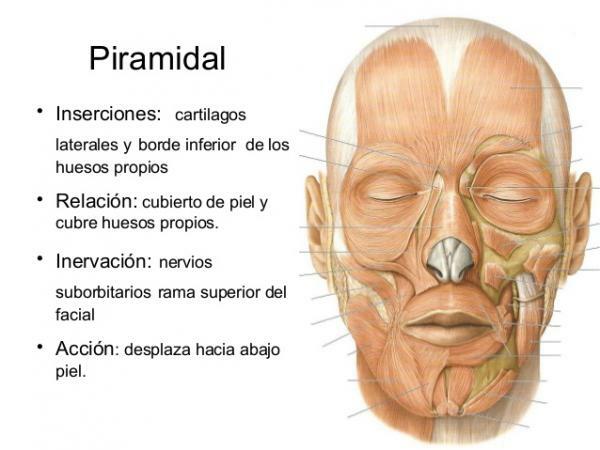LIST with ALL the muscles of the face and their function

Image: Slideshare
In humans, the face has 3 very important functions: express emotions, give us a certain facial appearance, which allows us to a great extent differentiate each other, and house the receptors of four of the five senses: sight, hearing, smell and taste. The fifth sense, touch, although it is extensible throughout our body, is especially important in one area of the face: the lips. To perform these three functions, it is key that the face has muscles, which allow the movement of the parts that form it.
The face is made up of a total of 43 muscles. Who would have thought that 43 muscles could fit on such a small surface!? In this lesson from a TEACHER we will look at the muscles of the face and their function. If you want to know which muscles you work when you frown, pout, wrinkle your nose, or smile, read on!
We begin this lesson on the muscles of the face and their function by talking to you about the uppermost area of the face. Within this area of the face there are more than 10 muscles, flat and thin. Most of them are ring-shaped, with the center at the eyes. Its function is, mainly, to give mobility to the eyes and eyebrows although they also have to do with expressiveness. Some of the most important muscles are:
- Corrugator and hero muscles: They are responsible for the movement of frowning and relaxation of the eyebrows.
- Orbicularis muscle of the eyelids: It is the muscle responsible for closing the eyes, both gently and when we squeeze them strongly. To open the eyelids, the orbital muscle works together with the levator muscle of the upper eyelid (in synergy), which is part of the muscles of the eyeball.
Other muscles in this area are: Pyramidal muscle (extending from the frown to the beginning of the nose) or superciliary muscle. Another important muscle of the face, very flat and thin, is the occipito-frontal muscle, which goes from above the eyebrows to the crown.
In this other lesson we will discover what are the neck muscles.

Image: Slideshare
More muscles are concentrated in the nose area than you might think at a time, due to its low mobility and small surface area. In addition, most of the muscles are related to respiratory function and only one, the pyramidal muscle, in charge of wrinkling the nose and that goes down from the eyebrows to the bridge of the nose, is related to expressiveness. The most important muscles of the nose are:
- Mirtiform muscle: is responsible for closing the holes in the nose or nostrils.
- Transverse muscles of the nose and dilator of the nose: both work together (synergistically) to open the nose openings

Image: Slideshare
The most muscles of the face they are concentrated in the region of the mouth and lips. In this area, the muscles are responsible not only for mobility and expression, but also for chewing, vocalizing, etc.
- One of the most important muscles of the face, specifically the mouth, is the buccinator muscle, located on the cheeks, between the "cheek" and the ends of the mouth. This muscle is responsible for pulling back the corner of the lips, increasing the transverse diameter of the mouth, and is involved in many actions: keeping food between teeth while chewing, whistling or playing wind instruments or while removing food that has become trapped between the gums and the lip.
- Another muscle of the face with an important function is the risorio muscle. This small muscle is triangular in shape and is located on the side of the face. Its function is the opposite of the buccinator, it is responsible for retracting the corners of the lips and intervenes, as its name suggests, together with the zygomaticus major and zygomatic minor, in laughter and the smile. In addition, the zygomaticus major, zygomatic minor, risorio and others such as the orbicularis of the lips allow to place the mouth and vocalize and "place" the voice in the face, that is, help other structures to correctly generate the sounds that we issue.
- Another muscle responsible for the expression of emotions is the square chin muscle. This muscle is found in the part of the chin, below and inside another muscle called a muscle. triangular lips. Both muscles are responsible for moving the lower lip and the corner of the lips down, respectively, when we "pout."
- Finally we will talk about masseter. The masseter is the main chewing muscle. It is a short muscle, more or less rectangular in shape and very strong, which is made up of two groups of muscle fibers or fasciae. This muscle is the one that generates the most force but, during chewing, muscles are involved in the part closest to the mouth, the lips and even the neck, but especially the tongue.
And with this we finish this lesson on the muscles of the face and their function, a perfect way to understand the entire anatomy of the human face to the fullest.

Image: Slideshare


